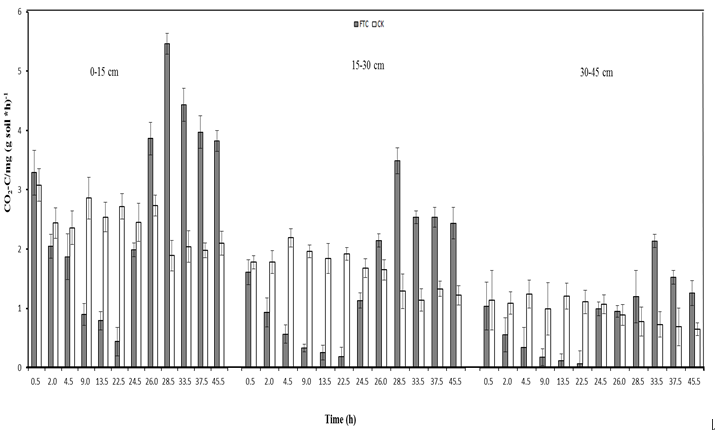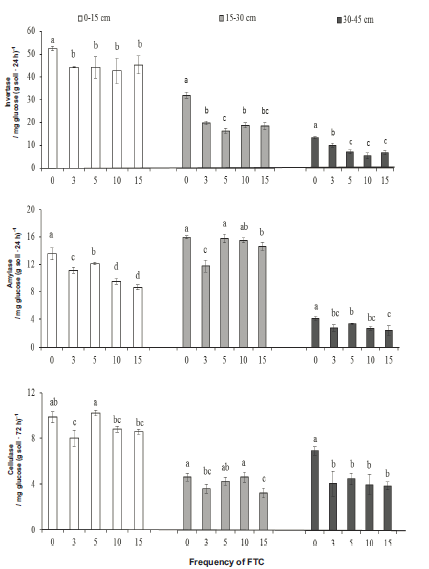Soil freezing–thawing cycle (FTC) is an important factor controlling C dynamics in mid–high latitude regions, especially in the permafrost regions are impacted by global warming. Nonetheless, the response of C cycling in the deeper active layers of permafrost regions to FTC remains far from certain. Thus, wetland and climate change team selected a study site-permafrost peatland located in the Xing’anling Mountains, NE China, and characterized the emission of CO2 from soils of multiple depths as impacted by FTC and its relationship with active organic C (OC) and enzyme activities. They collected soil samples from three soil layers (0–15, 15–30, and 30–45 cm) of an undisturbed permafrost peatland, and then subjected them to various freezing (10 to –10°C) and thawing (–10 to 10°C) cycles. Soil CO2 emissions, two active OC fractions, and activities of three enzymes were monitored during incubation periods.
The results showed that at the thawing stage of the first FTC,CO2 emission rates in the three soil layers presented transient peaks being about 1.6–1.7 times higher than those of the unfrozen control sample. Although FTC did not change the overall patterns of decreasing CO2 emission along the soil profile, FTC significantly reduced the amount ofCO2 emission when compared with the unfrozen control sample, possibly because the smallCO2 emission at the freezing stage neutralized the peak of CO2 emission at the thawing stage. This study suggests that in the active layer of permafrost peatlands, CO2 emission during FTCs may be lower than the emission under higher temperatures.
Meanwhile, FTC significantly increased water extracted OC release from the three soil layers, about 1.2–1.6 times higher compared to the unfrozen control sample, indicating that soil carbon loss in the form of leachate may increase during freezing–thawing periods. Additionally, the CO2 emissions impacted by FTCs were significantly correlated with active OC fractions and enzyme activities, which indicated that active OC and enzymes were sensitive to FTCs, and surviving microbes and enzymes might use the increased liable substrates and induce the CO2 emission during freezing–thawing periods. Thus, their studies will enable further understanding of how the C dynamics in mid–high latitudes of permafrost regions under global warming.

Figure 1: Peat CO2 emission rates during freezing and thawing periods in the first FTC. Values are means and standard deviation bars (n = 3); FTCs, freezing-thawing cycles.

Figure 2: Response of peat active organic C fractions to FTCs. Values are means and standard deviation bars (n = 3); different letters over bars indicate the significant differences between freezing–thawing cycles at P < 0.05. WEOC, and water extracted organic C; MBC, microbial biomass C.FTCs, freezing-thawing cycles.

Figure.3 Responses of peat enzyme activities to FTCs. Values are means and standard deviation bars (n = 3); different letters over bars indicate the significant differences between freezing–thawing cycles at P < 0.05. FTCs and freezing-thawing cycles.
This research was sposored by the Chinese Academy of Sciences, National Natural Science Foundation of China, and CAS/SAFEA International Partnership Program for Creative Research Teams in accordance with“Strategic Priority ResearchProgram – Climate Change: Carbon Budget and RelatedIssue”. The results were published in Journal of Plant Nutrition and Soil Science (Jiaoyue Wang, Changchun Song, AixinHou, Lili Wang. CO2 emissions from soils of different depths of a permafrost peatland, Northeast China: response to simulated freezing–thawing cycles. Journal of Plant Nutrition and Soil Science. 2014, 177, 524-531.).